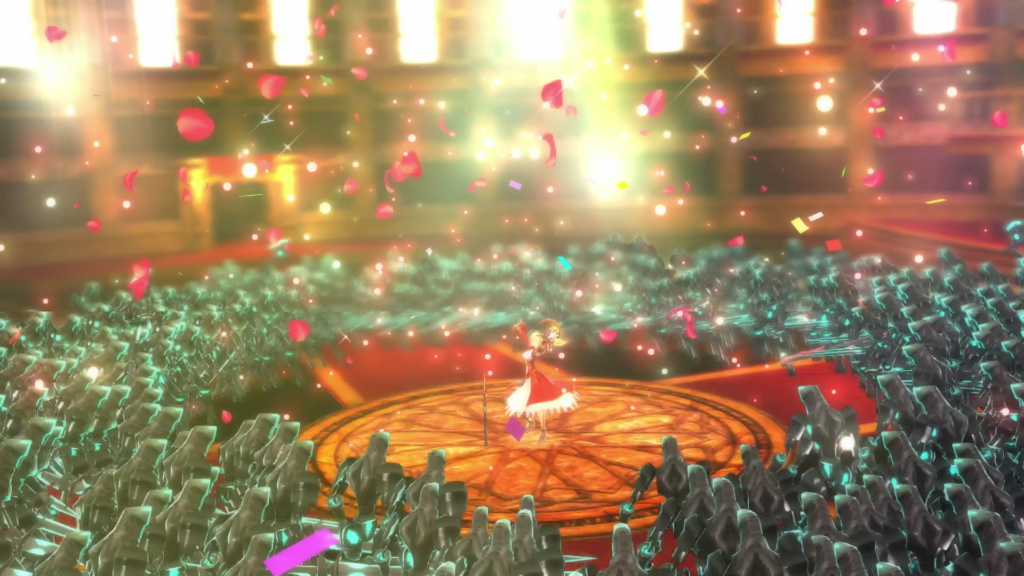Word by Word: The Journey Up Fate Mountain
Hi everyone, Ryan here. Sorry I haven’t blogged in a while, but I’ve been busy running the localization ofFate/EXTELLA, among a few other projects.
Of all the localization projects I’ve been a part of, going all the way back to Suikoden V, I can safely say thatFate/EXTELLA has been both the most challenging and the most rewarding.
The Fate series, mainly written by Japanese author Kinoko Nasu, has always been known for its distinctive literary style. Its volumes of dialogue and description are flush with poetic turns of phrase, references to world history/mythology/fiction, and, after over a decade’s worth of material, callbacks to the series’ own well-established lore. Extella, despite being an action game, boasts enough text to fill a good-sized RPG, all in that same distinctive style. Looking at those huge, oblique script files for the first time felt like looking up a sheer, looming cliff face, with just a rope and pickaxe in hand.

As we started climbing that cliff, we encountered lines that made the whole office scratch their heads. One of Tamamo’s lines, for example, has her say (with the context of having just been lightly wounded), “この程度の痛み、馬耳東風に糠に釘、焼け石に念仏ですよーだ。” — which literally translates to, “For this level of pain, it’s quite useless to turn a deaf ear and I’ll just pray to Buddha on a hot stone.” Several native Japanese speakers came together to ponder that one, eventually puzzling out that the line was a deliberately mangled mishmash of three different Japanese idioms, all referring to doing something foolish and futile. In our rough draft of the English script, bits and pieces of which appeared in the E3 demo, we edited this line to, “Is that the best you can do? You haven’t got a prayer!” That conveyed the same message, and included some of the same imagery, but departed from the style of the original line. To get the same point across without losing that style, we eventually came up with, “You might as well try to push a boulder through the eye of a needle, uphill both ways!” Similar lines appear throughout the script, including entire dialogue trees revolving around Japanese puns. In each case, we’ve done our best to convey the intended meaning while staying as closely as possible to the original line’s tone and tempo — while alsomaking each line sound “in character.”

We’ve said it before, but one of the most important aspects of any good localization is, of course, preserving each character’s “voice,” their own unique speaking style and personality. Ten different characters can express the same message ten different ways (or 108 different ways, if you’re working on a Suikodengame), and ideally, a reader who knows the characters should be able to look at a particular line, without its name tag or character portrait alongside it, and be able to tell which character said it. Since part of Fate’scentral premise involves a variety of historical and mythical figures coming together to battle, each character comes from a very different time and place, with a different cultural background, outlook, and set of goals and desires. Nero, one of the main characters, tends to speak in regal proclamations, treating everything she says in public like a grand performance, while being only slightly less extravagant in private. Tamamo, a legendary fox spirit known for cozying up to powerful rulers in order to corrupt them, speaks in playful, whimsical tones, while also using somewhat elevated speech to reflect her high-class station. Altera, a self-described “killing machine,” speaks the way she fights — with clipped, precise efficiency — except in those rare moments when she opens up. Gawain speaks as befits a noble knight of chivalric romance, Iskandar (aka Alexander the Great) roars with laughter at the thought of a good fight, and Gilgamesh, arrogant to the core, never hides his contempt for the “mongrels” around him.

Keeping those characters’ personalities front and center is especially critical when the characters are giving exposition, which — again, true to the series’ roots — they often love to do in this game. The more elaborate the lore, and the more critical it is to the events of the story, the more time the characters have to spend explaining it, which can bring any story to a halt if it’s not handled carefully. The key to presenting exposition successfully, and making the player care about it, is to convince the player that the characters care about it first and foremost. To that end, we did our best to illustrate the characters’ emotional states, couching the exposition in conflict, excitement, passion, and humor (when warranted by the original script, of course) whenever possible.
It hasn’t always been easy, and it’s taken about ten months from start to finish, but seeing it all come together — that’s been our reward. Little by little, we’ve seen our work integrate with the original game, joining with the music, Japanese voiceovers, camerawork, visual effects, and gameplay to help create a powerful gaming and storytelling experience. We’re all proud and honored to have had the chance to contribute to a series as well loved and respected as Fate, and we hope we’ve done it justice in the eyes of the fans.

We also hope that all players, Fate fans and newcomers alike, enjoy the journey through the characters’ struggles and adventures as much as we do.Fate/EXTELLA launches in North America for PS4 and PS Vita in January 17, 2017.
